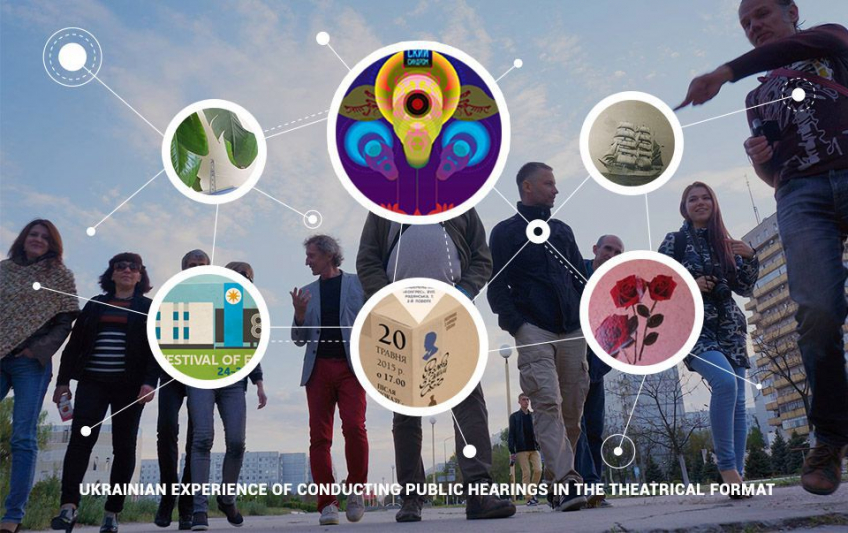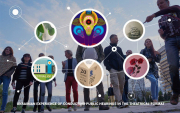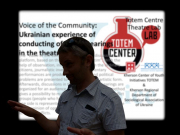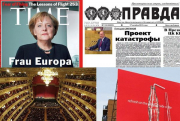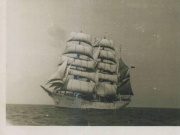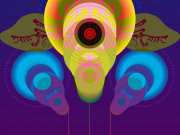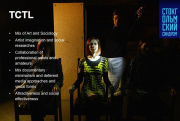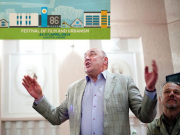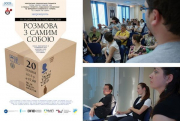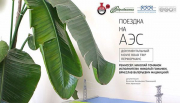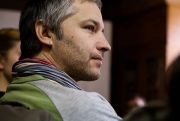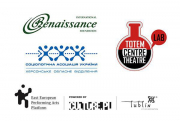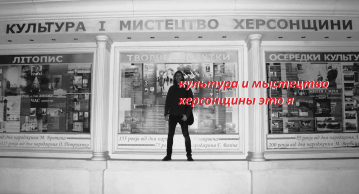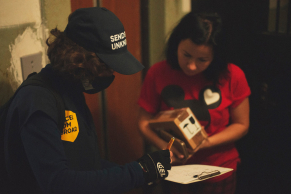VOICE OF THE COMMUNITY: UKRAINIAN EXPERIENCE OF CONDUCTING PUBLIC HEARINGS IN THE THEATRICAL FORMAT
We want to represent a lecture, given at Munich "Spielart" Festival ("Art in resistance" section) on the 31 November, 2015. This lecture is about a work experience of public discussion platform in theatrical format.
Hello, my name is Mykola Homanyuk. I am from Ukraine, and I live in the city of Kherson. It is a river and sea port with a population of three hundred thousand people, and it is situated in the south of my country. I am here to represent Totem Centre Theatre Lab. Totem Centre Theatre Lab was created on the base of two non-governmental organizations: the Kherson regional branch of Sociological Association of Ukraine and the Centre of Youth Initiatives TOTEM. TCTL is an artistic group working at the combination of performing arts and social sciences in such spheres as documentary theatre, oral history and public activities. Since 2013 TCTL is a member of Eastern European Performing Art Platform. More information about Totem Centre Theatre Lab you can find on the totemlab web-site.

So the title of my lecture is Voice of the Community: Ukrainian experience of conducting public hearings in the theatrical format. Some theory for a start. Some of you may find something interesting in it, though I doubt it, to be honest. In the beginning of the famous novel by Jules Verne In Search of the Castaways the characters extract a letter in the stomach of a shark. As you remember, the letter was inside a sealed bottle. In this case the message form and the communication channel are of the utmost importance. It means that the bottle with the letter tells us about what had happened to the sender before the letter was read by us. In the case of Captain Grant, nothing good had happened. His ship had been wrecked and he needed help. But, unfortunately, there was no telephone, no Internet and even no simple post office on the desert island. This is what the bottle tells us. “Wait a little, dear Helena, wait; we must have patience with bottles; but if I am not much mistaken, this one will answer all our questions”.

The words of the writer Jules Verne have something in common with the ideas of the famous philosopher and researcher in the field of media Marshall McLuhan. One of McLuhan’s most significant creations is a profound idea he used in the title of one of his books The Medium Is the Message. There are a lot of interpretations of this book. One of them tells that no matter what the message content is, the event gains public significance not by itself, but due to the message about the event transferred via a communication channel. In this case, the message form and the communication channel are of the utmost importance.
Different social groups pick different communication channels. Big companies, influential political parties, banks choose expensive TV channels, widely promoted newspapers and web sites. They buy large advertising spaces in city center and busy streets. We know or we can guess whose bullhorn a particular newspaper or TV channel is: they may belong to a certain government institution, oligarch or political party. For example, everybody knows that the newspaper Pravda was the official voice of the Communist Party of the Soviet Union. A particular social group also choose their own genre of art (in the same way as they choose their own mass-communication tools). Some choose opera, some prefer big-budget films, and some opt for painting. The groups deprived of access to the great deal of costly mass-communication tools choose documentary work. Documentary photography, films, theatre are also somebody’s (using soviet terminology) ‘official voices’ or ‘extensions’, but in the manner of McLuhan.

A gay couple from Russia (the winner of the competition in 2015), the migrants from Somalia (2014), the inhabitants of the Gaza Strip (2013), a battered Afghan woman (2011) chose the WorldPressPhoto contest as a tool of their extension or a way of their communication with the world. Their message was successfully delivered to the recipient. Due to the artistic format used in these cases it was possible to reduce considerably the distance between the inhabitant of Urozgan and a citizen of the Netherlands, for instance and to deliver the message from Afghanistan to Amsterdam without any mail cover check and mail expenses. Furthermore, all these ‘letters’ were multi-authored even when there was only one author. They represented particular social groups. “Life for lesbian, gay, bisexual and transgender (LGBT) people is becoming increasingly difficult in Russia. Sexual minorities face legal and social discrimination, harassment, and even violent hate-crime attacks from conservative religious and nationalistic groups”, says a laconic description to the winning photo on the web-site of the contest.
It’s of greater interest to observe such extensions within the analysis of the progress of new genres. In terms of Eastern, Europe we can mention such genres as verbatim-theatre, documentary theatre, witness theatre, in other words, the theatre of true life stories.
Even a brief analysis of the texts of documentary plays reveals that prime interest of playwrights is focused on the social groups, which have no other ways of communication: national and sexual minorities, irregular migrant, homeless people, convicted inmates, harassed political opposition, groups with specific food preferences, feminists, physically challenged people, special service officers, different freaks and so on, in other words, those people who are usually included into the category of outcasts. In case when some characters, representing particular social groups, appear on stage we can say that other means of communication are inaccessible or ineffective for them.

It gave us the basis for organizing a permanent platform, a specific ‘scenic newspaper’ which could give a chance to speak out to those who in fact don’t have the right to the freedom of expression, as well as to associate such people with those who are willing to listen to them and to try to change something. Initially, the method of verbatim was used as a basis. We collected interviews with representatives of different target groups, wrote plays based on the interviews, presented them in the form of performances, and discussions of the performances were organized afterwards. It is very important that raw information collection is held in line with sociological approaches, such as adequate samples and general representativeness. A play is supposed to be a comprehensive research report. As for the format of a discussion, it should be very similar to public hearings. A qualified moderator, experts, officials and journalists are invited to take part in discussions. During our discussions, we do not review artistic merits of a play, such as acting, directing, etc. All attention is drawn to the subject matter of the performance. The causes of the problem, its state, and possible solutions are spoken about. I don’t want to say that the problem is solved right away after the performance, but the participation of journalists and bloggers may ensure an extensive spread of the problem within public sphere. In this case, the experts become ‘customers’ of the communication channel, and traditional media and social networks become open for ‘closed’ groups. Theatre becomes a mediator between socially vulnerable groups and the rest of the society.
Why have we chosen the theatrical format of all others? In Ukraine, public hearings as a form politico-social activity may be said to have become discredited.
They are frequently held for the purpose of manipulation or under orders of the customers, and they quite often turn into a farce. Very often, public hearings are attended by ‘professional participants’. And, in general, public hearings are either boring or tending to turn into a scandal. The theatrical format is attractive for everybody including those, who attend neither hearings nor theatre. As a result, the theatrical form brings people to hearings and makes them more politically active, and a particular problem brings other people to theatre as such.
Tovarishch Gorch Fock
(2012)
Let us now proceed to the practical aspects and our experience. The first high-profile project of Totem in collaboration with KIT e.V. (Oberhausen) was the performance Tovarishch Gorch Fock (2012). The performance tells about the sailing ship Gorch Fock. Gorch Fock was built in 1933 in Germany. After the war, it ended up in the Soviet Union as part of the reparations. In the USSR, the Gorch Fock turned into the Tovarishch (which means ‘comrade’ or ‘friend, mate’). It became a training ship of Kherson Maritime Academy. From the 1950s until the early 2000s, the Tovarishch was one of the main attractions and symbols of the city of Kherson. Dozens of thousands of cadets had practical training on its board. The Tovarishch was the first ship of independent Ukraine to display the Ukrainian national flag. In 1998, the Tovarishch left for London to be repaired, and it never came back to Kherson. In the result, the Tovarishch was sold first to a Russian company registered in Cyprus, and then to a German organization. In Kherson, most people think that it happened in the result of a corruption scheme. For a year, we interviewed the participants and witnesses, both in Ukraine and in Germany, studied the documents, and collected the data. In the result we presented a performance-report. In this performance, the real participants of those events, the company names, the names of officials, and the amounts of money were mentioned. It is possible to qualify what we did as ‘theatrical investigation’. Its results were demonstrated in the form of performance. Nobody was imprisoned or removed from office afterwards. At some stage we understood that the truth demanded bigger authority, that police authorities at a high level should have been involved. Nevertheless, it doesn’t mean that the project was unsuccessful. The performance was attended by the people who had never been to a theatre before: seamen, workers associated with the Tovarishch, teachers of the maritime academy, ex-cadets, ordinary public of Kherson. Involvement of untheatrical audience became a side effect of the project. Furthermore, the project showed that there’s no need to have the Tovarishch physically. Artistic projects may be one of the means of preserving historical memory about important events in the life of the Tovarishch. Such projects also bring forward a unifying idea for the citizens of both Kherson and Stralsund, the city of the current location of the Tovarishch-Gorch Fock. During the project and after it, we continuously cooperated with German organizations. Unfortunately, the efforts to extend the project didn’t find any support. I suppose, that the subject ‘Tovarishch-Gorch Fock’ is still awkward for both Ukraine and Germany.
The title The Voice of the Community appeared a year later, in 2013. The result of it was the performance Stockholm Syndrome, based on the principles of liquid television. The Stockholm Syndrome is a compilation of short performances and interludes, in which everybody (the authors, the respondents, and the audience) tries to answer the question: “why do we at the same time love and hate our native city?” The main purpose of the performance was the development of territorial community affiliation, social activism, and responsibility for the situation in the city. This time, theatre as one of the means of communication with the world was chosen by ‘invisible people’: clients of a marriage agency, sellers of lottery tickets, vegans, gamers, prisoners, and officers of penitentiary system. This project strengthened the principal approaches of our laboratory: the mixture of art and sociology, the mixture of professional actors and amateurs, the mixture of documentary minimalism and various forms of visualization of a document, the mixture of visual appeal and social efficiency.
Recruitment of amateurs pursues several goals. First, an amateur is an actor-document who brings their speech, pronunciation, gestures, body, and their own perception of the world. That is why we do not try to hide their personal singularity behind theatrical speech or standard movements. Such fusion of the text of the play and the text of an actor brings additional or even principal realism to the stage. Furthermore, an amateur means new five or ten spectators in the hall (an actor’s relatives, colleagues, and friends) who are potentially new participants of a discussion and propagators of the ideas of the project even after a performance and public hearings. It contributes to the involvement of untheatrical audience. In return, participation of amateurs as characters determines the lifetime of performances. As a rule, we show our performances only several times, usually once or twice.
Inner Slavutych
More
Focusing on the territorial community was determining for the project Inner Slavutych. Slavutych is the city specially built after Chernobyl accident for the workers of the nuclear power plant and the liquidators of Chernobyl disaster. When the nuclear power plant was closed down, the city faced many challenges which put into question the very existence of the city. The city needs a new development strategy. We decided to create a performance about Slavutych which would show the inner view of ordinary citizens on the situation in the city. We conducted a series of interview with ordinary inhabitants of the city. But we didn’t discuss what everybody usually discusses: the habitual issues closely connected to Chernobyl disaster. We talked about their ordinary life, about the surrounding at home and in their families. Starting to talk about their kitchenware, photos, souvenirs we gradually approached to more profound topics. In the result, the performance Inner Slavutych, shown as part of the film and urban festival ‘86’, became an alternative development strategy of the city; and the discussion after the performance turned into public hearings. The performance attracted some officials, especially the mayor of Slavutych who took a very active part in public hearings and happened to be the biggest critic of the play. It is not a scene out of the performance. It is the speech of the mayor of Slavutych during the hearings after the performance. The new experience reinforced the tendency of discussions taking more time than performances.
Aleksandr Zhukovsky’s
House Museum
More...
Social groups are not the only field of work of our laboratory, but individuals as well. This activity is combined with work in new circumstances, at conceptually new venues. The performance Aleksandr Zhukovsky’s House Museum takes place in the dwelling of the multiple child family Zhukovskys. Aleksandr Zhukovsky is a naïve artist and sculptor. By training Aleksandr is a cook. He spent several years in prison. He has no regular place of work. From time to time, he works either on a construction site or in the security service. He has a peculiar technique of painting: Aleksandr draws with pencils, pens, printer ink, and bleacher. He also works with unconventional materials as a sculptor: bricks, foam plastic, foam rubber, and wool. Our laboratory decided that we shouldn’t wait till the artist dies and the museum would be organized in his flat. The museum can be organized while the person is alive with the help of theatrical methods. The performance Aleksandr Zhukovsky’s House Museum is a documentary happening. It is an excursion to Zhukovsky’s apartment acted together with the audience. One can learn Aleksandr Zhukovsky’s life history during the excursion. The guide will show you Zhukovsky’s favorite mug and razor, Zhukovsky’s broken vacuum cleaner, Zhukovsky’s children, etc. A fine art expert will tell you about Zhukovsky’s creative work. The excursion money is given to Zhukovsky. The performance is a source of income for the artist.
Soliloquium
One of the recent projects is the verbatim performance Soliloquium. The performance was created under the impression of the work by the Odessa group of meditation, which continuously carries on dialogues both between the Maidan supporters and between those who do not support the Maidan. As you know, the confrontation between pro-Russian and pro Ukrainian activists ended up in the tragedy in the trade union building. Forty seven people died. Violent antagonism to the ideas of each other makes it impossible to establish any dialogue between the supporters of different development paths of Ukraine. That is why the supporters of different way have distorted and stereotypical perception of each other. They simply cannot hear each other. Even if we gather them at the same place and try to organize a dialogue, it may come to the bad end: mutual insults or even physical conflict. On the other hand, the people who are disloyal to the present authorities try to conceal their opinion. It makes a direct dialogue with them impossible. The use of the verbatim method makes such a dialogue not only possible but also quite safe. We work according to a standard plan. First, we interview disloyal respondents. We guarantee full confidentiality and safety for them. It makes them more sincere and free in their expressions. Based on these interviews, a play is compiled and a performance is staged. The standard plan ends here. A discussion after a performance is held according to another plan. The opinion of politically disloyal citizens is presented by the actors; the audience usually consists mostly of the citizens loyal to the political mainstream. In such situation, if not a constructive dialogue is possible, but at least politically loyal citizens have a possibility to know the opinion and the arguments of those who, in usual conditions, prefer to keep silent.

In conclusion, I’d like to show you the documentary performance A trip to the power plant. A few words about Zaporizhzhya nuclear power plant: it is the biggest power plant in Europe and the biggest working nuclear power plant in the world. The plant provides with electricity many regions of Ukraine including annexed Crimea. Zaporizhzhya power plant is situated on the bank of the Dnipro river at the distance of about 200 kilometers from the ATO zone. So, let’s start. I invite you to make a trip to the nuclear plant. The starting point is Kherson.
The text is prepared in the frames of the project "Theater of Mutual Understanding: Discussion Platform of Southern Ukraine on the base of Documentary Theatre" supported by International Renaissance Foundation.
 |
